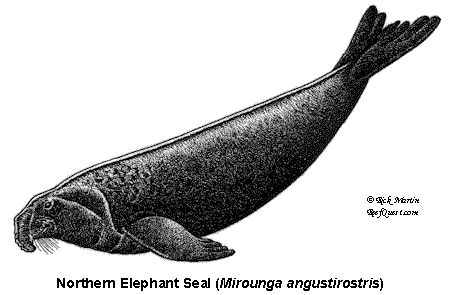Predatory Behavior of Pacific Coast White Sharks*
Only recently have we begun to understand how Pacific Coast White Sharks feed. Over the last 23 years, David Ainley, Peter Pyle, Scott Anderson and other biologists at the Point Reyes Bird Sanctuary on Southeast Farallon Island (off San Francisco) have been keeping records of White Shark predation events. Attacks on California Sea Lions, Northern Fur Seals, Elephant Seals, pelicans, and even five divers have been recorded off Southeast Farallon. The vast majority of attacks took place close to shore, where these potential prey creatures tend to congregate. Anderson and a colleague, A. Peter Klimley, have also seized opportunities to conduct grass-roots, innovative - and sometimes bizarre - experiments in order to understand how the White Shark chooses and captures its prey.
Photographs showing the silhouettes of a pinniped and a surfboard from below have been widely distributed throughout the media. The similarity between the two shapes is somewhat compelling. Small wonder that "mistaken identity" has been cited as a probable explanation for White Shark attacks on surfers by some researchers. From morphological and physiological studies, it is known that White Sharks have excellent photopic (bright-light) color vision. But does the White Shark actually rely on such a search image? Recently, Scott Anderson has equipped a surfboard with an underwater camera and trolled this rig along the surface at South Farallon. Analysis of the filmed attacks on the board reveal that the Great White typically stalks its prey by swimming along the bottom and strikes by launching a lightning-fast vertical attack. This is consistent with the theory that the White Shark makes use of a search image when hunting pinniped prey.
 The Great White uses different techniques when attacking different species of pinniped. Northern Elephant Seals (Mirounga angustirostris) are not easy to catch. They are station wagon-sized, phenomenal repeated deep-divers, and very powerful swimmers. But at the surface, Elephant Seals have all the maneuverability of an aircraft carrier. In order to tackle an Elephant Seal, a Great White typically attacks from below and behind, immobilizes the seal with a tremendous bite to the hindquarters, then retreats and waits for its prey to bleed to death before returning to feed. Hunks of blubber and flesh are sawed away at the surface, but taken to or near the bottom to be swallowed. The Great White uses different techniques when attacking different species of pinniped. Northern Elephant Seals (Mirounga angustirostris) are not easy to catch. They are station wagon-sized, phenomenal repeated deep-divers, and very powerful swimmers. But at the surface, Elephant Seals have all the maneuverability of an aircraft carrier. In order to tackle an Elephant Seal, a Great White typically attacks from below and behind, immobilizes the seal with a tremendous bite to the hindquarters, then retreats and waits for its prey to bleed to death before returning to feed. Hunks of blubber and flesh are sawed away at the surface, but taken to or near the bottom to be swallowed.
This so-called "bite-and-spit" strategy is typically employed by White Sharks feeding on adult Northern Elephant Seals, but does not hold for pinnipeds of lesser dimensions. Smaller seals, such as the 1.5-meter Harbor Seal (Phoca vitulina), are grabbed at the surface and pulled underwater until they stop struggling, then eaten at or near the bottom; juvenile Harbor Seals are simply plucked from the surface like grapes and eaten whole (Harbor Seals seem to be the perfect White Shark snack food: they're abundant, slow-moving, and bite-sized - sort of Phoca McNuggets!) The 2.5-metre-long California Sea Lion (Zalophus californianus) is a more powerful swimmer than the Harbor Seal, and is typically attacked by a White Shark from below, struck in mid-body, dragged below the surface until it stops struggling, then eaten at or near the bottom.
Reflecting upon the White Shark's predatory modus operandi, several interesting patterns emerge. It is interesting that for all three species of pinniped, the White Shark stalks along the bottom, attacks at the surface, and feeds at or near the bottom. It is also interesting that about 50% of the divers that are attacked by White Sharks off the Pacific Coast are hit at the surface, with the shark usually grabbing the legs of the victim. What is especially intriguing, however, is that divers attacked by White Sharks are let go after the initial strike two out of three times. It seems unlikely that the mighty Great White can be so incompetent a predator that prey - once in its mouth - escapes 67% of the time. What's going on here?
To find out, A. Peter Klimley devised a bizarre modification of Scott Anderson's surfboard experiments. Klimley used a similar rod-and-reel rig to troll the waters off South Farallon with the carcasses of seals, pigs, and sheep (If Hemingway had known, he would have spun in his grave: The Old Man and the Sheep?) White Sharks attacked all three types of bait, but consistently rejected the sheep carcasses. Klimley speculates that the high energy demands of the White Shark may be a factor in rejection of food items. On a per-unit mass basis, fat or blubber is a very energy-rich food. Since seals and pigs tend to be quite fatty, they are accepted after the initial strike; sheep tend to have a significantly lower fat content, and may thus be rejected as low-quality food. So, putting all the pieces together, it seems that divers might sometimes be attacked by White Sharks because they are visually mistaken for seals or Sea Lions, but then spat out because they're just too damn skinny to be a worthwhile meal.
If you have observed a shark predatory event, especially one involving a White Shark, and would like to assist the Shark Research Committee's studies on a volunteer basis, please report your observations using the appropriate form.
* adapted from an article by Rick Martin. . |